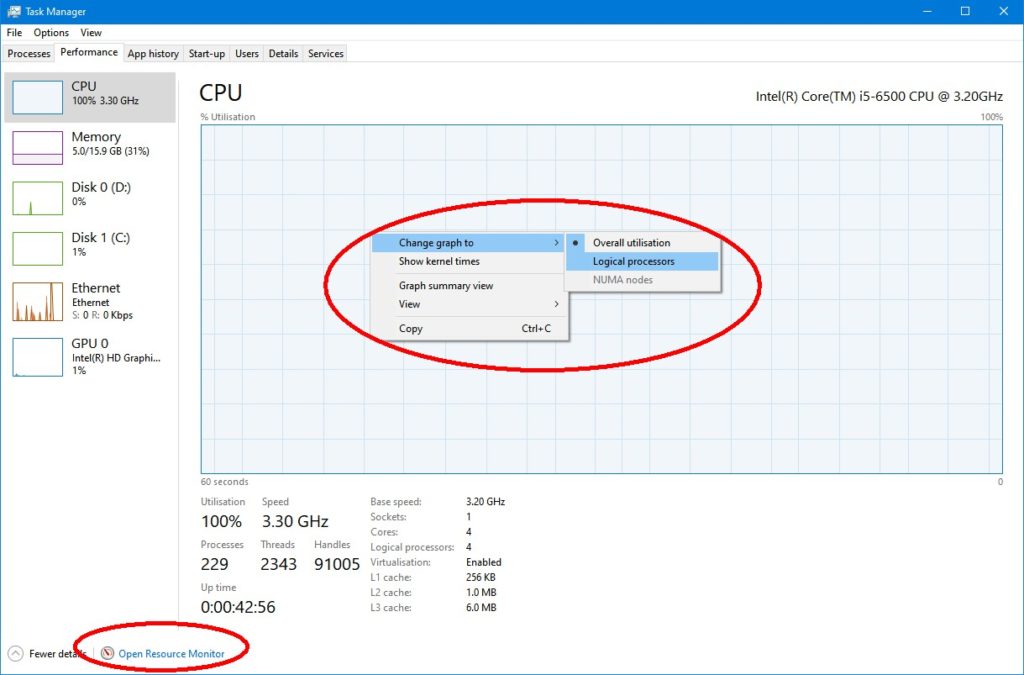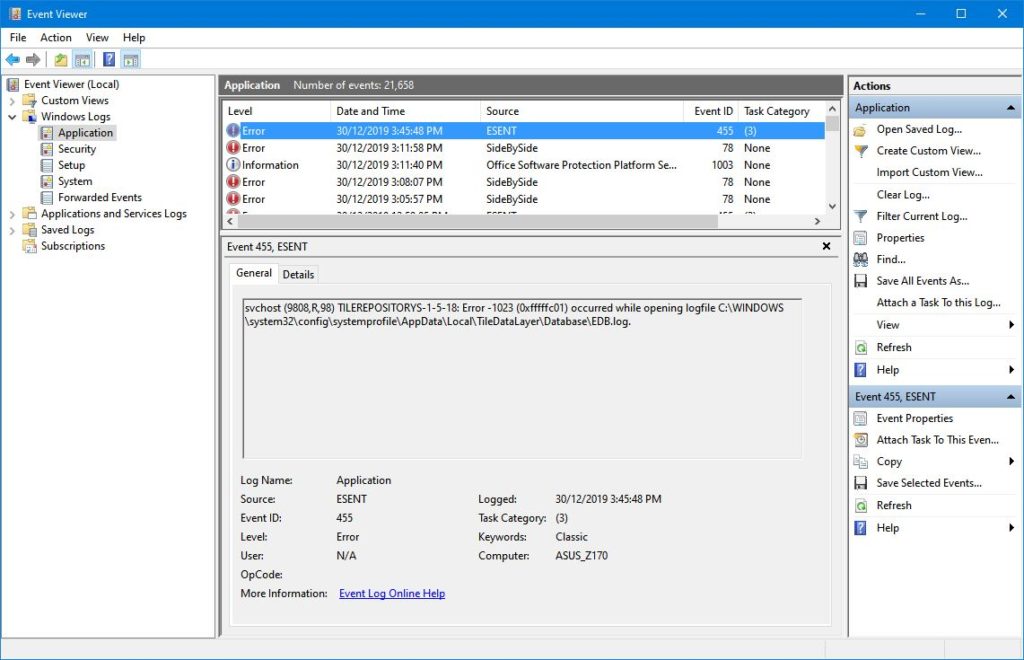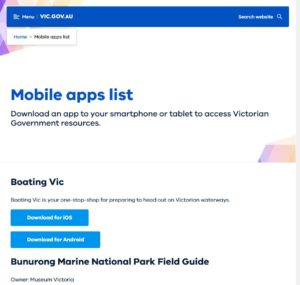East SIG Report November 2019
2nd February 2020
Neil Muller
The November meeting opened with George Skarbek conducting his usual Q&A segment.
Q: In the last week Windows File Explorer has refused to open when I click its icon. This action has occurred after I loaded Clover, a File Explorer replacement. When I installed Clover it took an extremely long time to load so I decided to go back to using for File Explorer. After a search of the internet for solutions, I turned off File Explorer in Task manager then turned it back on again, but that had no effect. I then ran System File Checker but that didn’t find any issues either. If I wasn’t attending this meeting my next move would be to uninstall Clover.
(Trevor Hudson) Have you tried System Restore to set your PC back to when File Explorer was working?
(Answer) After I installed Clover I downloaded a number of large Windows Updates before I realised I had a problem. As my Internet connection is very slow (1.3 Mbps generally) I decided not to use System Restore unless other options to correct the problem fail.
A: System File Checker would have been my first suggestion. I’d then look at Task Manager and Resource Monitor at the bottom of the Task Manager window.
(A show of hands revealed only 10% of those attending use Task Manager or Resource Monitor. George then proceeded to describe its use to solve the problem of a slow computer.)
Right click on Windows Start menu and select Task Manager.

Figure 1 – Task Manager
If things are going slowly you need to determine whether it’s caused by Windows itself or an application. From Task Manager under the Performance tab right click on the graph of the CPU and do 2 things, select Change graph to then select Logical Processors. (Refer figure 1) The reason for doing this is to show all CPU cores. If you have multiply cores one may be running flat out and the others idling. The other area to look at here is to Show Kernel Time. Put simply the Kernel can be viewed as the core system of Windows. The dark blue in the graph is the kernel times. With no other applications running you can determine whether the slowdown is due to Windows or an application.
The Resource Monitor is located at the bottom of the Task Manager window (Figure 1) and will show what is eating up your CPU. Look at each of the 4 tabs, CPU, Memory, Disk and Network. If the CPU activity is high for a particular file right click on the file and select terminate process. If the graph in the Disk tab shows a high reading your disk may be constantly reading and writing which will slow your system down. Network is usually insignificant and not likely to cause a system slow down. These are the areas you start looking when things are slow. Once you’ve found the culprit, chase it back and uninstall it.
From the Task Manager window you should also look at Startup as is also an area that can slow a system down. Many of the programs in startup don’t need to be running all the time, as they are using up your memory. Right click on any unwanted Startup items and select disable. This doesn’t delete the program but just prevents it from running when the computer fires up.
You should also look at the Window log files. The logs can be found in Windows Event Viewer. To do this go to Control Panel Administrative Tools Event Viewer and look at the Windows Logs section. The two main areas to look at under Windows Logs are Application and System. (Refer figure 2) Scroll down the list to the right and look for any errors that could cause a slowdown. You can get more information for all errors but you will need a good knowledge to determine whether it’s a problem or not when using this approach. If an error comes up repeatedly, look on the web for more information.

Figure 2 – Windows Event Viewer
Update: Initially when Clover was installed on the member’s computer it took an extremely long time to load, but now opens in an acceptable time. When the member clicks the File Explorer icon or uses the shortcut Windows key + E, File Explorer still does not open. Instead, Clover now opens and displays all the Quick Access folders similar to his File Explorer display. As Clover has a number of features that File Explorer doesn’t have, such as tabbed windows, the member has decided to keep using Clover instead of File Explorer.
Q: How can I tell what version of Windows I’m running?
A: To determine the version of Windows you’re running press the Windows key + R and type winver then press Enter.
Q: Sometimes my desktop PC will go weird and very sluggish. I’ve looked at Task Manager and the CPU shows 13%. Is 13% fairly normal?
A: If it’s 13% then your disk I/O has gone crazy. Something is causing this problem and it’s usually caused by your antivirus. It’s likely some program is repeatedly scanning every single file on your system causing your PC to go slow.
Q: There’s a maintenance setting you can turn on in Windows 10, is it worth turning on and what does it do?
A: I haven’t turned on Windows 10 Automatic Maintenance setting so I can’t comment.
[Author] According to the MicroSoft website, Automatic Maintenance is a feature that automatically runs daily scheduled maintenance tasks when you’re not using your computer. It aims to keep your computer healthy and optimized by running specific tasks, such as disk optimization and defragmentation, system and apps updates, security and malware scans, diagnostics, and other tasks with the sole purpose of keeping your device healthy and running at its peak.
Q: I’ve recently got a new computer with a USB WiFi dongle. Whenever I power it up I have to unplug the dongle and plug it back in again for Windows to recognise it. Is there a setting I should be looking for so that the WiFi dongle is recognised when I power the computer up?
A: I have an elderly computer with a USB WiFi dongle and the WiFi always works when I fire up my computer. To my knowledge there’s no setting for the WiFi to come on or off. (Tech Ed: The WiFi dongle could also be tried in a different USB port, and this may produce a better result)
Following Q&A, new Melbourne PC President, David Stonier-Gibson gave a short talk to members on his views for the future of MelbPC. The visit to East SIG was also to see how different SIGs function, to meet different members and to get their views on the future of MelbPC. David’s found most SIG members are happy with the current operation of the club, but have a strong desire for it still to be around in 15 years’ time. To that end they accept that there needs to be change for that to occur.
David spoke about his short time on the MelbPC committee being an advantage. This has enabled him to be free from the burdens of the past, which previous presidents George Skarbek and John Hall had to clean up. Thanks to George and John, the club is now in a good financial position and membership is now only slowly declining. The committee can now look more to the future and plan for MelbPC to be around in another 15 years’ time.
David noted that fashionable things these days are not only PCs but making things, 3D printing, new technologies etc. To attract new members a new group called the Science Tech Group has been established which is aimed to suit younger people. This has resulted in younger people joining the Melbourne Computer Club (MelbPC) and a number of these younger members being elected to committee.
David then outlined a few of his ambitions for MelbPC but stressed these are only his thoughts at this time. One idea that might be of interest to older members who don’t like driving at night, is to hold daytime monthly meetings. It might be a different format to the current evening meeting being more social and could involve lunch. Other ideas are games events, half day courses or workshops such as getting started with 3D printing, Raspberry Pi etc., a photography contest where members meet at 10, are given an half hour briefing then leave to take their photos. They then return at 12 to judge each other’s photos. A lot of things will need to be put in place before any of these ideas become fact.
An active question and answer session followed. One area that generated a number of questions was the need for a superior quality projector at Moorabbin. Members present felt a projector with a minimum resolution of 2k (2560 x 1440) was needed to show videos and more importantly for showing digital photographs. Some other questions related to; committee portfolio allocation (not yet decided), a question on membership (currently at 1,600 and now only declining slowly), how many active and inactive members we have (estimated only 300 read PCUpdate otherwise unknown), how can we attract younger mature age, say 50 to 60 year olds to join as members (currently targeting younger 20 year plus in Science Tech Group), encourage business to sponsor events or presentations (e.g. 3D printing), sponsorship of the magazine as it’s a window to the club (only 12 members subscribe to a printed version of PCUpdate).
After a refreshment break, Stewart Bedford gave an interesting presentation titled “Useful Government YouTube videos and Mobile apps for Victorians”. Stewart commenced by looking at some of the more unusual (read “useless”) apps from the current 54 apps produced by the Victorian Government. These apps can be downloaded from the Victorian Government website “Mobile apps list” at https://www.vic.gov.au/mobile-apps-list. Most are available for both Android and iOS devices as shown in the landing page in figure 3.

Figure 3 – Mobile apps list at https://www.vic.gov.au/mobile-apps-list
Before loading an app, Stewart recommends you first look at the reviews, the number of installs and when the app was last updated. Stewart found that most of the information offered in the Mobile apps list above is generally available from alternate websites. He queried whether the cost to produce some of these is a good use of resources. As apps can cost between $100 and $400k to produce, Stewart believes most are a complete waste of money, given many have recorded only a small number of downloads and that the same information is available elsewhere.
On a slightly more positive note is the mobile Myki app. The Myki app allows passengers to use their smart phone to tap on and off public transport, instead of using a plastic Myki card. To describe how mobile Myki works the short video “Adding a new myki” at https://www.youtube.com/watch?v=zHTgE2GgeHs was played. Stewart rates this app as a mess, as it’s only half done and doesn’t work all the time. It’s only available on Android phones, you have to install Google Pay first, it can only be used with newer Android phones with NFC (Near Field Communication) and you need VISA or MasterCard to pay Google Pay. Stewart believes the Opal System in Sydney is a more common sense approach. Passengers using the Opal System can use their credit card to touch on or off when travelling on public transport. Could it be that money goes on the Myki card in advance of any trip, compared to paying by credit card only when taking a trip?
A site Stewart does use a lot is my.gov.au. This is not an app but a website that you need to log into. It was included in the presentation as the website has now been made mobile friendly. When logged in, the site gives the appearance of an app and acts like an app. To give a brief outline of how to setup and use myGov, the YouTube video “New Look myGov” at https://www.youtube.com/watch?v=FV6hPRrHnOA was shown. Additional video tutorials to assist users are also available from the myGov YouTube channel at https://www.youtube.com/channel/UCPtuqZ_Izgm_jsjRE_OX-ww . Stewart was impressed with the range and information in these tutorials. He found them useful as they gave users a good insight to options available on the myGov website.
Services available through the myGov site include, Australian Job Search, Australian Taxation Office, Centrelink, Child Support, Dept. of Health, Veteran Affairs, Aged Care, Medicare, My Health Record, National Disability Scheme plus a few others. You can’t sign into your myGov account through the website without user authorization. When you go to log onto myGov, an access code is sent to your smart phone by SMS. If using a mobile device you can also get an access code back through the myGov Access app. The myGov Access or Code Generator app creates codes which you enter when signing into your myGov account. These codes are used instead of SMS codes or secret questions. The code generator is available from the Google Play store. The myGov Access app can be downloaded at https://download.cnet.com/myGov-Access-code-creator/3000-20432_4-78117993.html).
Although Medicare and Centrelink can be accessed through the myGov site, a separate app is available for both. The Medicare app is called Express Plus Medicare mobile app and the Centrelink app called Express Plus Centrelink mobile app. Stewart uses both the Medicare and Centrelink apps and finds them useful and easy to use. He then outlined some of the many services available through these apps.
To conclude, Stewart reviewed the Victorian Public Transport app. Compared to overseas country’s such as Singapore, he felt the app had a long way to go. Stewart then played the video “Getting started on public transport”. This video can be found at https://www.youtube.com/watch?v=Q57hExF0YFE. The app gives real time metropolitan train, tram and bus information, network maps, train station information, location of Myki retail outlets, ordering a Myki card etc. but has had mixed reviews.




